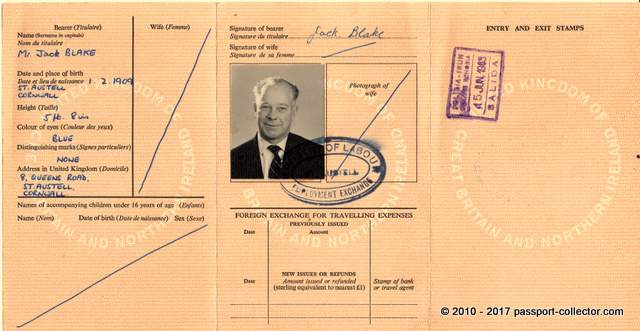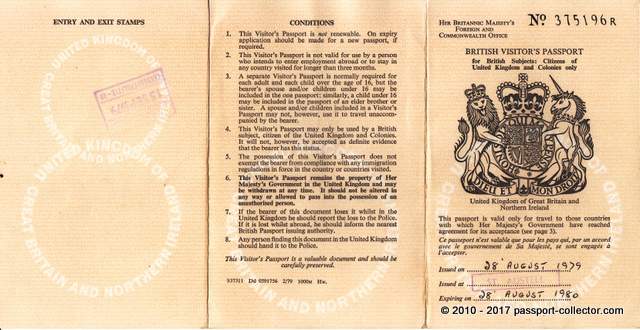The British Visitors Passport – The Simplicity Of A Travel Document
British Visitors Passport
The British Visitor’s Passport (BVP)
Introduced in March 1961, the simplified passport was available to UK residents for over 8 years. The document was a 3-fold card obtained from post offices with the applicant’s birth certificate or specified identity documents.
Its sole purpose was for individuals to actively engage on holiday or private visits, lasting no more than 3 months, to specified European countries. It was valid for one year only. Due to many concerns arising in connection with the easy availability and security of this document, the BVP was withdrawn with effect from 1 January 1996. British Visitors Passport

 Version from 1963
Version from 1963
The Independent reported in June 1994
“The one-year British Visitor’s Passport – used by more than 2 million holidaymakers a year – is to be abolished”. The review, at least partially prompted by threats from Spain to stop recognizing the BVP from 1995, sought the opinion of experts in the travel trade about the future of the one-year passport which gains entry to most west European countries for a three-month period. Two-fifths of its holders travel to Spain.
Millions of holidaymakers pick up their passport from post offices at the last minute. It costs pounds 12 and is available on proof of identity. The family passport costs half as much again as a single one. If issued for a family or husband/wife, only ALL could travel, not a single person mentioned in the BVP.
Versions
- The first British Visitor’s Passport (BVP) had gray pages on the inside and beige outside
- In the second version of the BVP, the inside changed to white
- The third had a white inside with small flecks of colored thread distributed across it. These glow under ultraviolet light
- The ultimate iteration, effective from July 1989, expanded its reach to include Tunisia, Yugoslavia, and Canada, influenced by a suggestion from a British reader.
Besides the BVP, there was an even simpler form of document valid for day trips to France known as a British Excursion Document! Literally, a piece of paper with a photograph on it, which was stamped by the Post Office! It cost about £2.50 and was valid for 3 days.

 Version from 1979
Version from 1979
FAQ Passport History
Passport collection, passport renewal, old passports for sale, vintage passport, emergency passport renewal, same day passport, passport application, pasaporte passeport паспорт 护照 パスポート جواز سفر पासपोर्ट
1. What are the earliest known examples of passports, and how have they evolved?
The word "passport" came up only in the mid 15th Century. Before that, such documents were safe conducts, recommendations or protection letters. On a practical aspect, the earliest passport I have seen was from the mid 16th Century. Read more...
2. Are there any notable historical figures or personalities whose passports are highly sought after by collectors?
Every collector is doing well to define his collection focus, and yes, there are collectors looking for Celebrity passports and travel documents of historical figures like Winston Churchill, Brothers Grimm, Johann Wolfgang von Goethe. Read more...
3. How did passport designs and security features change throughout different periods in history, and what impact did these changes have on forgery prevention?
"Passports" before the 18th Century had a pure functional character. Security features were, in the best case, a watermark and a wax seal. Forgery, back then, was not an issue like it is nowadays. Only from the 1980s on, security features became a thing. A state-of-the-art passport nowadays has dozens of security features - visible and invisible. Some are known only by the security document printer itself. Read more...
4. What are some of the rarest and most valuable historical passports that have ever been sold or auctioned?
Lou Gehrig, Victor Tsoi, Marilyn Monroe, James Joyce, and Albert Einstein when it comes to the most expensive ones. Read more...
5. How do diplomatic passports differ from regular passports, and what makes them significant to collectors?
Such documents were often held by officials in high ranks, like ambassadors, consuls or special envoys. Furthermore, these travel documents are often frequently traveled. Hence, they hold a tapestry of stamps or visas. Partly from unusual places.
6. Can you provide insights into the stories behind specific historical passports that offer unique insights into past travel and migration trends?
A passport tells the story of its bearer and these stories can be everything - surprising, sad, vivid. Isabella Bird and her travels (1831-1904) or Mary Kingsley, a fearless Lady explorer.
7. What role did passports play during significant historical events, such as wartime travel restrictions or international treaties?
During war, a passport could have been a matter of life or death. Especially, when we are looking into WWII and the Holocaust. And yes, during that time, passports and similar documents were often forged to escape and save lives. Example...
8. How has the emergence of digital passports and biometric identification impacted the world of passport collecting?
Current modern passports having now often a sparkling, flashy design. This has mainly two reasons. 1. Improved security and 2. Displaying a countries' heritage, icons, and important figures or achievements. I can fully understand that those modern documents are wanted, especially by younger collectors.
9. Are there any specialized collections of passports, such as those from a specific country, era, or distinguished individuals?
Yes, the University of Western Sidney Library has e.g. a passport collection of the former prime minister Hon Edward Gough Whitlam and his wife Margaret. They are all diplomatic passports and I had the pleasure to apprise them. I hold e.g. a collection of almost all types of the German Empire passports (only 2 types are still missing). Also, my East German passport collection is quite extensive with pretty rare passport types.
10. Where can passport collectors find reliable resources and reputable sellers to expand their collection and learn more about passport history?
A good start is eBay, Delcampe, flea markets, garage or estate sales. The more significant travel documents you probably find at the classic auction houses. Sometimes I also offer documents from my archive/collection. See offers... As you are already here, you surely found a great source on the topic 😉
Other great sources are: Scottish Passports, The Nansen passport, The secret lives of diplomatic couriers
11. Is vintage passport collecting legal? What are the regulations and considerations collectors should know when acquiring historical passports?
First, it's important to stress that each country has its own laws when it comes to passports. Collecting old vintage passports for historical or educational reasons is safe and legal, or at least tolerated. More details on the legal aspects are here...
Does this article spark your curiosity about passport collecting and the history of passports? With this valuable information, you have a good basis to start your own passport collection.
Question? Contact me...

